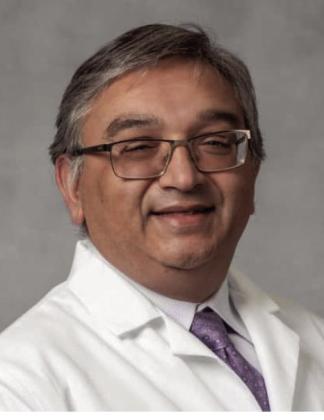IN THE REALM OF ONCOLOGY, there are three traditional tools that can be utilized either individually or in various combinations to treat cancer—surgery, chemotherapy, and radiation therapy. In recent years, these mainstay therapies have been augmented with other leading-edge treatments, such as immunotherapy, hormone therapy, and others.
According to radiation oncologist Dhaval Parikh, MD, of The Toledo Clinic Cancer Centers, a good way to understand the role that each of the three basic cancer-treatment tools plays is to compare cancer to a burning building. “In this scenario, surgery is like a firefighter’s axe in that it’s used to cut away the cancer; chemotherapy is like a sprinkler system, delivering treatment to the whole body; and radiation therapy is like a firehose, delivering powerful, focused treatment to just one area,” he says.
“In simplified terms, radiation therapy involves the use of high-energy x-rays to kill cancer cells, Dr. Parikh explains. “The radiation is very focused and travels through the body to the site of the cancer, where it causes ionization that changes the cancer cells.”
Because radiation doesn’t distinguish between cancer cells and normal, healthy cells, radiation oncologists always employ measures to minimize the dose that reaches healthy cells. However, some healthy cells receive the full dose during treatment and are injured nonetheless.
“What’s interesting,” Dr. Parikh states, “is that healthy cells recover very quickly from this injury compared to cancer cells. In fact, most of the repair occurs within six hours of treatment, so the healthy cells can recover completely before the next course of treatment. Cancer cells, on the other hand, are locked in the growth phase and are focused on replicating, so when they get injured, they stay injured. With each consecutive treatment, they sustain more and more damage, so by the end of treatment, the cancer dies off but the healthy cells remain.” Radiation therapy is very targeted by nature, but Dr. Parikh notes that new technologies and techniques have now made it possible for radiation oncologists to target their treatments with even greater precision. Among these advances is the advent of 4D scanning, which accommodates for movement of the tumor as the patient breathes, significantly increasing the accuracy of treatments. Another example is the use of PSMA PET scanning to identify prostate cancer cells anywhere in the body. This form of imaging is used in conjunction with a radioactive tracer that binds to a protein called prostate-specific membrane antigen (PSMA), which then lights up on the scan so doctors can precisely pinpoint where the cancer has spread and target treatment accordingly.
As with any cancer treatment, radiation therapy can cause side effects. “However,” says Dr. Parikh, “the effects are limited to the site being treated. For instance, if you’re treating the skin, the treatment site may become red and irritated, or if you’re treating the head, the patient may lose hair. The organs in the area you’re treating determine the side effects. In most cases, side effects come on gradually during treatment, peak toward the end of treatment, and get better soon afterward.”
Dr. Parikh emphasizes that the three basic components of cancer care are not in competition with one another, but rather work together to create an integrated, interdisciplinary approach to treatment that is stronger than the sum of its parts. “Cancer treatment is very collaborative, with surgeons, medical oncologists, and radiation oncologists all working closely together. Our patients commonly see all three specialties so they know exactly what their treatment options are and can be confident they’re getting the most appropriate and effective care possible,” he states. The Toledo Clinic Cancer Centers, located at 1200 Medical Center Parkway in Maumee and 4126 N. Holland Sylvania Road, Suite 105 in Toledo, also provides imaging, laboratory, chemotherapy, specialized pharmacy, and IV services. The cancer center consists of 13 physicians and 11 advanced practice providers. The cancer center also has satellite centers in Napoleon, Bowling Green, Wauseon, Bellevue, and Monroe.
The Toledo Clinic Cancer Centers has earned Patient-Centered Specialty Practice recognition and Oncology Medical Home recognition from the National Committee for Quality Assurance. Oncology homes align systems and resources with coordinated care focused on cancer patients and their needs. This reduces fragmentation, supports shared decision making, and improves the patient experience. They are the first oncology practice in the state of Michigan and the second oncology practice in the state of Ohio to receive this recognition.
For more information, please call The Toledo Clinic Cancer Centers at 419-479-5605. ✲


